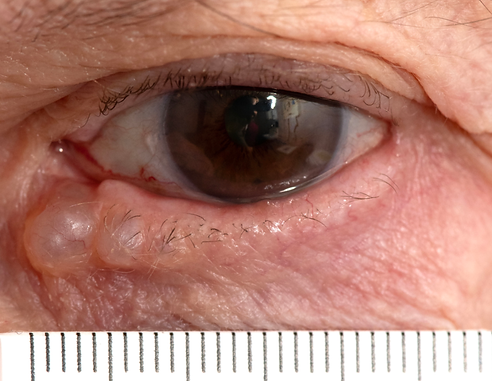Eccrine Hidrocystoma
Author: Shazma Shahid
Chief Editor: Dr Daniel Keith
Hidrocystomas are harmless, fluid-filled cysts that develop from sweat glands classified as apocrine or eccrine, depending on which sweat gland they arise from.
These often get worse with sweating, heat, and humidity but tend to shrink in colder weather. They are most often found on the central face and are more common in middle-aged women. Exact diagnosis requires biopsy and histopathologic examination, but this can carry a risk of scarring.
Multiple eccrine hidrocystomas have been reported to be associated with Graves’ disease, Parkinson’s disease, idiopathic craniofacial hyperhidrosis, and prolactinoma.
Macroscopic Appearance
They are typically dome-shaped well-demarcated lesions with a bluish-purple tint centrally and range from 1 to 6mm in diameter. They can appear alone or in groups. During hot or humid weather, these lesions will grow and/or multiply in number. They characteristically occur close to but do not involve the eyelid margin or effect eye lash growth.

Macroscopic example of two adjacent eccrine hidrocystomas on the lower eyelid.
Dermoscopic Appearance
Dermoscopy would reveal a well-demarcated, milky, ovoid/ dome shaped lesion with a homogeneous bluish-purplish tinge filled with clear fluid.
Some cases have reported pale halos surrounding the bluish papules.
The primary differential diagnosis for multiple eccrine hidrocystomas on the face includes conditions such as eruptive vellus hair cysts, comedonal acne, eruptive syringomas, pilomatricomas, and basal cell carcinomas. Dermoscopic features can help distinguish these conditions.

Two Eccrine Hydrocystomas correlating with the gross appearance as shown in the previous image.
Image courtesy of Dr. Stefania Mitsaki.
